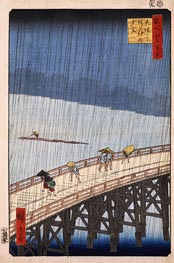
Ando Hiroshige Painting Reproductions 1 of 1
1797-1858
Japanese Ukiyo-e Printmaker
Here is the text with special characters removed or replaced to comply with `latin1_swedish_ci` encoding:
---
Hiroshige, born in 1797 in Edo (now Tokyo), was one of the last great masters of ukiyo-e - those haunting, dreamlike images of the "floating world." His name may not carry the flash of Hokusais, but Hiroshiges subtle brilliance shaped the art world both in Japan and far beyond its borders. He didnt need grandeur; his genius lay in simplicity - a quiet mastery that spoke through landscapes rather than the more gaudy figures of kabuki actors or courtesans so beloved by the ukiyo-e tradition.
Raised as the son of a fire warden, Hiroshiges path into art was not entirely conventional. By the time both of his parents died when he was still a boy, the post of fire warden had already passed to him, though his daily responsibilities were minimal. Art, clearly, was his true calling. Its said that he first tried to enter the studio of Utagawa Toyokuni, famed for his vibrant prints of actors and beautiful women. Rejected, Hiroshige instead joined Toyohiros school, a more subdued and refined mentor, who undoubtedly helped cultivate the poetic restraint that would become Hiroshiges hallmark.
Hiroshiges career is often defined by his monumental work, "Fifty-three Stations of the Tkaid," a series of prints created after his 1832 journey along the famed highway between Edo and Kyoto. Each station, each view, captured with an almost photographic precision but softened by an ethereal lyricism. You can feel the weight of the seasons in his landscapes - the delicate haze of rain, the heavy silence of snow, the ghostly silhouettes of distant mountains. Its this atmospheric sensitivity that elevates Hiroshiges work to something profoundly intimate. He invites you not just to observe, but to feel.
His output was staggering. More than 5,000 prints flowed from his hands, capturing every nuance of Japans natural beauty. "One Hundred Views of Edo" - his farewell masterpiece, completed in the years just before his death - stands as a love letter to the city of his birth, a poignant chronicle of its rivers, bridges, and temples. Yet, while his contemporaries often sought the theatrical, Hiroshige remained steadfastly focused on the subtle poetry of everyday life. He understood that sometimes a bend in the river or a solitary tree under snowfall could tell you more than a throng of figures in a marketplace.
Hiroshiges world was one of quiet marvels. Where Hokusais landscapes are stormy and epic, Hiroshiges are gentle, meditative. Its no surprise that the Impressionists, with their own fascination with light and color, admired him so greatly. Monet, van Gogh - they all recognized the quiet genius of this man who painted not just what he saw, but what he felt.
Raised as the son of a fire warden, Hiroshiges path into art was not entirely conventional. By the time both of his parents died when he was still a boy, the post of fire warden had already passed to him, though his daily responsibilities were minimal. Art, clearly, was his true calling. Its said that he first tried to enter the studio of Utagawa Toyokuni, famed for his vibrant prints of actors and beautiful women. Rejected, Hiroshige instead joined Toyohiros school, a more subdued and refined mentor, who undoubtedly helped cultivate the poetic restraint that would become Hiroshiges hallmark.
Hiroshiges career is often defined by his monumental work, "Fifty-three Stations of the Tkaid," a series of prints created after his 1832 journey along the famed highway between Edo and Kyoto. Each station, each view, captured with an almost photographic precision but softened by an ethereal lyricism. You can feel the weight of the seasons in his landscapes - the delicate haze of rain, the heavy silence of snow, the ghostly silhouettes of distant mountains. Its this atmospheric sensitivity that elevates Hiroshiges work to something profoundly intimate. He invites you not just to observe, but to feel.
His output was staggering. More than 5,000 prints flowed from his hands, capturing every nuance of Japans natural beauty. "One Hundred Views of Edo" - his farewell masterpiece, completed in the years just before his death - stands as a love letter to the city of his birth, a poignant chronicle of its rivers, bridges, and temples. Yet, while his contemporaries often sought the theatrical, Hiroshige remained steadfastly focused on the subtle poetry of everyday life. He understood that sometimes a bend in the river or a solitary tree under snowfall could tell you more than a throng of figures in a marketplace.
Hiroshiges world was one of quiet marvels. Where Hokusais landscapes are stormy and epic, Hiroshiges are gentle, meditative. Its no surprise that the Impressionists, with their own fascination with light and color, admired him so greatly. Monet, van Gogh - they all recognized the quiet genius of this man who painted not just what he saw, but what he felt.
1 Ando Hiroshige Paintings

Sudden Shower over Shin-Ohashi Bridge and Atake 1857
Paper Art Print
$52.13
$52.13
SKU: HIA-16892
Ando Hiroshige
Original Size: 37 x 24 cm
Metropolitan Museum of Art, New York, USA
Ando Hiroshige
Original Size: 37 x 24 cm
Metropolitan Museum of Art, New York, USA